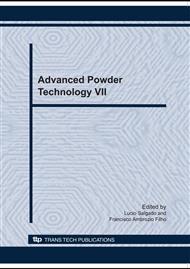p.819
p.826
p.832
p.837
p.844
p.848
p.854
p.860
p.866
A Method for an Improvement in the Quality of Diamond Composite Thermostable Material
Abstract:
It is still in focus the problem of obtaining high quality polycrystalline materials by means of sintering fine diamond powders. The most important task of this problem is the consolidation or improvement of the processed polycrystalline diamond. It is worldwide recognized that the plastic deformation of the diamond particles performs the most important role on the diamond powder consolidation. In some cases, the contact and shear tensions reconstruct the compact structure. In this work the sintering process used a mixture of micro and nanodiamonds. The sintering process was carried out in a toroidal high-pressure device. The effects of nanodiamond addition and sintering conditions on the microstructure and mechanical properties sintered diamond bodies were studied. The sintering parameters were pressure of 6.8 GPa and a temperature of 1850 K, and these conditions were maintained for 1 minute. Homogeneous sintered bodies were obtained, which have a Vickers' hardness over 40 GPa, and fracture toughness around 7.1 – 7.9 MPa.m1/2.
Info:
Periodical:
Pages:
844-847
Citation:
Online since:
October 2010
Keywords:
Price:
Сopyright:
© 2010 Trans Tech Publications Ltd. All Rights Reserved
Share:
Citation:


